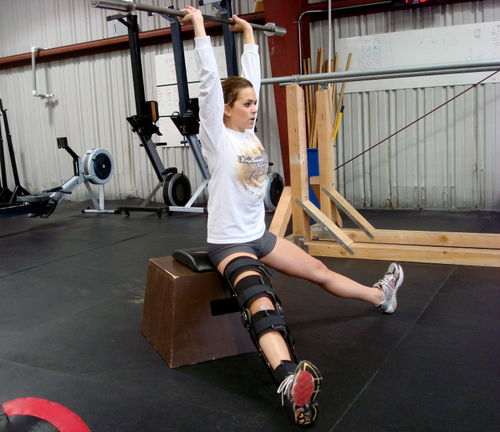I have spent the past 16 years helping athletes get back to their sport or desired activity following an injury. Whether dealing with muscle strains or ACL ruptures, every injured client shares the same goal of making a full recovery and getting back to their previous activity level. My purpose in writing a blog series on this topic is simply to share some pearls I have picked up along the way and to help others learn from my mistakes and successes.
Beyond the severity and nature of the injury itself, there are several considerations that play a significant role in the rehabilitation process including: the athlete’s emotions, goals, mental toughness, age, experience, previous medical history, relationships with parents/coaches/teammates, innate movement patterns, etc. I feel the first and perhaps most important step in the recovery process involves connecting with the athlete on an emotional level.

Injured clients want to know that their medical team (MD, PT, ATC and strength coach) really care about their well being, that they truly understand the impact of the injury on his/her life, and that they can provide the skilled care necessary to restore the body to its prior level of function. Too many times, we as health care professionals speak first espousing all our expertise and often forget to LISTEN enough. Our athletes want to feel special during this low point in their life.
Pearl #1 – Spend more time listening on the first meeting/visit to gain a thorough understanding of how the injured athlete “feels” and views their current injury. I spend the majority of my eval time interviewing the client to allow them to describe their physical symptoms, but more importantly fully elaborate on their goals, perceptions and thought processes surrounding the rehab timeline and expected outcome. Knowing how they feel (afraid, angry, depressed, etc) is essential in order to connect as well as properly motivate/coach throughout.
Many athletes (especially those who have been injured before) tend to want to dictate how things will go or pre-determine when they will be able to return to the playing field. I will re-direct them, but it is wise to listen to them tell you what did not work for them in the past. Mistakenly, they often compare their injuries to past experiences of their own or peers. While prior experience dealing with the same injury is helpful mentally preparing for the recovery process, it is critical to remind the athlete coach and family that no two injuries are exactly alike and that the recovery process will be guided by specific milestones and processes as opposed to “what happened in the past.”
Pearl #2 – Thoroughly educate the athlete on his/her condition, the anticipated timeline for return to sport and the implications for pushing too hard and fast in rehab. Never assume he/she does not want to know all the details. Emphasize that your goal is to return to sport as soon as possible but in a safe manner that ensures adequate recovery and minimizes the risk for re-injury. Telling your athletes the “why” behind each and every decision (exercise selection, reps, sets, practice limitations, etc) will help put the athlete at ease early on and foster trust and collaboration. This is an absolute must. To ensure success, we need the athlete to honestly and openly communicate throughout. I tell every athlete I work with that we are a team dedicated to the same goal – this achieves buy in from them up front as they see I am fully committed and invested in them.
In almost all cases, I find the athletes fear losing their starting position and/or letting down the coach far more than long term damage to their bodies. As such, I tell them it really is okay to rest and recover. They seemingly feel guilty about not contributing and their self-worth may markedly diminish. Recognizing this and encouraging them to be patient, stay the course and see the light at the end of the tunnel is very important. You see, the emotional and psychological healing is a HUGE part of the process during rehab. Being an advocate for the patient and not the sport provides security and emotional support for the injured client.

Pearl #3 – Communicate to the athlete that it is best to under promise and over deliver when it comes to telling the coach how soon he/she expects to return. In my experience, coaches tend to pressure athletes, parents, ATC’s and PT’s for updates and subtly (in some cases not so subtly) try to speed things up. I never want my athletes to feel outside pressure to be healthy and return when in fact they are not ready. I tell them to deflect anger/frustration from a coach onto me and ensure that the coach knows who is leading/making the return to play decisions from the get-go.
My athletes are always relieved when I get actively involved here because they are not the ones saying no. Not all coaches pressure athletes either, but nonetheless the athlete generally wants and feels an obligation to return fast. Coaches love it when we say it will be 2-3 weeks and then an athlete goes back in 7-10 days. That is not to insinuate that I mislead anyone with respect to rehab, but more so that I opt for a conservative projection for both the athlete and coach so that disappointment and unmet expectations are kept to a minimum.
My final point involves harnessing the the metal profile of an athlete which generally revolves around being challenged and winning. You see, injured athletes still want to overcome challenges and get better day to day. They want to be actively involved in the rehab process and not just “sit on the bench.”

Pearl #4 – Actively challenge your athletes throughout the rehab process, and celebrate their accomplishments along the way. Providing constructive feedback (verbal, visual and kinesthetic) on their performance and praising them as each goal is met goes a long way in helping them regain their confidence as well as overcome the fear that their body will not perform as well as it once did in the past. Remind them that there will be ups and downs at times just like sports, but that your plan and little goals along the way will ultimately get them back to full strength again no matter how much they may complain about the hard work (LOL).
Do not be afraid to push and challenge them either. Rehab should become like a hard workout for them at some point as they near full strength. My aim is to make them mentally sound through hard work and training as indicated by the condition itself. I have even had some parents tell me their child was stronger, faster, tougher and sometimes just plain better on the court/field after rehab then prior to the injury itself.
I don’t attribute this to anything special on my end, but more to the fact that I helped the athlete reach down inside and get a little more from within. Perhaps, they simply lacked confidence before? Maybe they were holding back, or they simply may not have connected with their current coach? Regardless, I see my PT role as more than just doing rehab. I get the privilege of coaching men and women of all ages to not only regain their physical prowess, but more importantly to strive to be their mental and emotional best. Restoring their athletic mindset is an absolute must. Do it early on, coach it along the way, and in the end you will surely find success.
So, if you are an injured athlete or a sports medicine provider, I hope my words have resonated in some way with you and perhaps will benefit you or the lives of those you will impact moving forward. I am blessed to help people every day and I want to thank you for reading this and sharing in my aim to provide the very best care possible for injured athletes..

